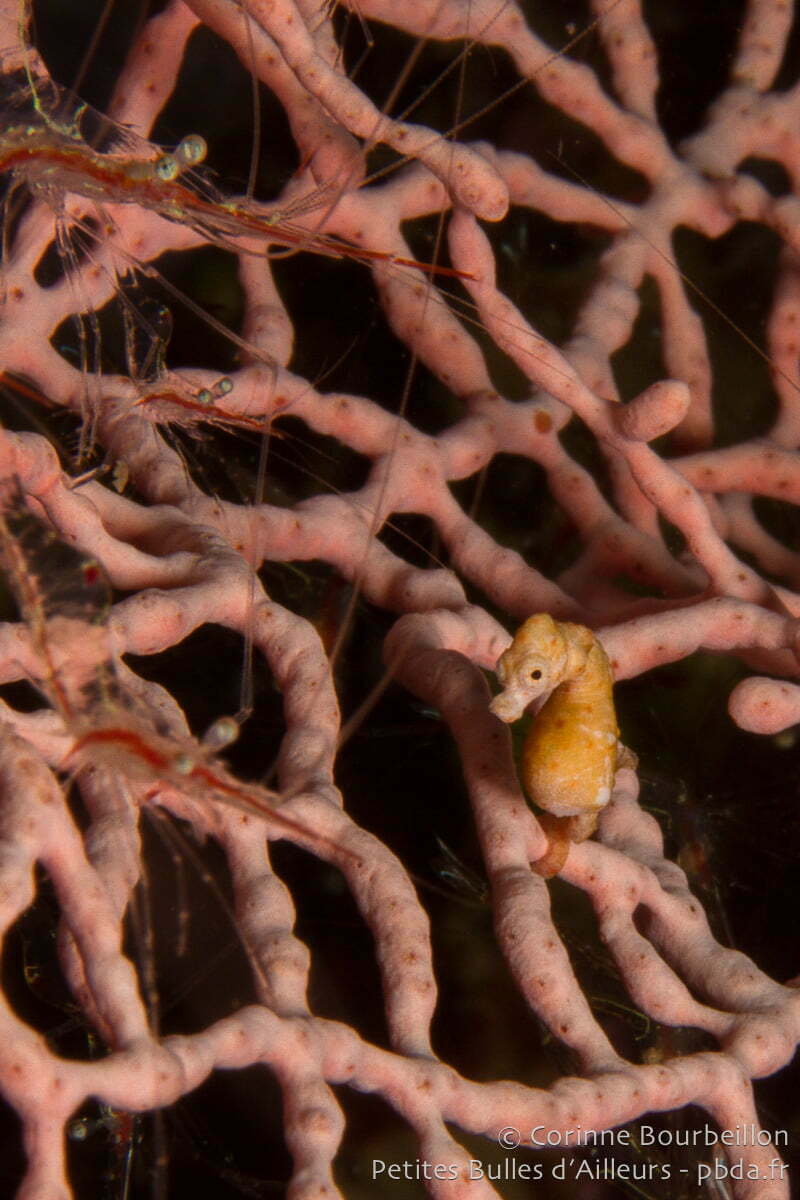Indonesia: Weda [Halmahera] + Bangka [Sulawesi] - March 2013
Dear English-speaking readers, this page is an automatic translation of an article originally written in French. I apologise for any strange sentences and funny mistakes that may have resulted. If you read French, click on the French flag below to access the original, correct text:
Nothing more annoying to photograph than a seahorse-pygmy. Too small. Too well camouflaged. Too shy. But its delicate plastic is well worth some efforts.
Half-naked asses!
After the background imagesLet's go to macro photography ! In the waters of Weda Bay, at HalmaheraIn Indonesia, where I was in March 2013, I am lucky to have some choice models: the pygmy seahorses.
But photographing them is not easy. A real challenge, even...
First concern, with these miniature sea horses: they are more than "pygmy", they are downright half-naked! To be able to observe them, some divers even take a magnifying glass under water with them. That is to say...
With their size of about one centimeter (sometimes less), pygmy-hyppocampuses are really difficult to spot. They can be found by patiently scanning the branches of the huge gorgonians of Weda Bay.
The quest is a bit like looking for a needle in a haystack, sometimes... But you get there. The proof.
 Fortunately, I am helped by the eagle eye of my Indonesian guide, Radyal.
Fortunately, I am helped by the eagle eye of my Indonesian guide, Radyal.
It helps me to see them, in the huge coral fans, and then, above all, to find them again, when, with my mask stuck to the viewfinder of my tank, I moved a few centimeters and lost sight of the branch where the little sea horse on which I had set my heart on is hiding. Patience and calm are needed to succeed in photographing pygmy seahorses.
We met two species during our dives at Weda.
The one that has pink or orange bumps, which serve as camouflage in the gorgonians of identical color, is a seahorse bargibanti. The little yellow with a bald head answers to the sweet name of Denise.
Shy people
Second concern: the little seahorses do not like to be photographed at all.
Every time I point my macro lens at them, I get the same acrobatic act around the gorgonian branch. Here they are, slowly swiveling on their coiled tail, until they pass on the other side, ostensibly turning their back to me...
I take a deep breath, walk around the gorgon, take up my position, readjust the angle of my flash and the opening of the camera. And zut! I missed again.
The development is very delicate to succeed, on such small creatures, it is played to the millimeter. But their shyness adds to the difficulty.
 And I really feel like they're taunting me... Hop! I turn my back on you again, I don't like pictures.
And I really feel like they're taunting me... Hop! I turn my back on you again, I don't like pictures.
😆
The repetition of this subtle camouflage maneuver - once, twice, three times - it gets very annoying!
But, by dint of perseverance, I still manage to draw the portrait.
My photo equipment : the Eos 7D and the lens Canon 60mm f / 2.8 EF-S Macro.
And I am the stubborn type, I must say... Able to stay stuck in front of a gorgon for long minutes, under the benevolent eye of my guide, who patiently spins out his string of bubbles.
He waits for me to finish, to lead me to another coral fan, a few meters away. He even made a small round trip, to check that the gorgonian is still inhabited, since his last visit, while I am complaining in my regulator about the lack of cooperation of my tiny model.
On one of the gorgonians we visited, we found a small family of sea horses. But here, I don't try anymore. Impossible to have everybody on the picture.
I just took a few shots, for memory, with two seahorses in the frame. It's not that common to capture more than one at a time!
When it's time to sort out the images, in the evening, on my MacBook Air, I eliminate a lot of them, without any qualms. But I have come a long way since my very first images of a seahorse-pygmy with a compact camera, in 2008 (see right here and the)…
I do a lot less "macro" since I have my new toy, the fisheye lens Tokina 10-17This is a great place for underwater pictures. But in Weda, the tiny sea horses gave me back the taste of "small".
🙄
Indonesia: Weda [Halmahera] + Bangka [Sulawesi] - March 2013









